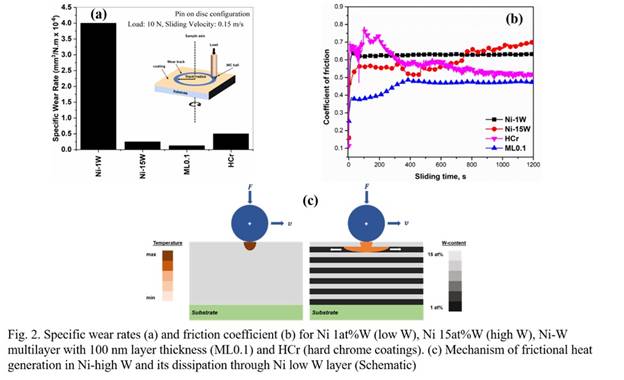Ministry of Science & Technology
Electrodeposition process developed for Ni-W alloy coatings can reduce friction
Posted On:
27 NOV 2024 5:05PM by PIB Delhi
A new ecofriendly electrodeposition process for depositing Ni-W alloy coatings with multilayered architecture can reduce stress due to friction and prevent Heavy energy loss and failure of moving machine parts, such as gears.
Heavy energy loss and failure of moving machine parts, such as gears, in automobiles is attributed to relatively higher friction and wear and tear losses. Numerous efforts have been made to alleviate this issue through surface coatings/oxide layers so that the direct contact between the moving parts is eliminated. Among the sliding wear contacts, the heat generated at the contact surfaces allows the formation of oxide layers.
With the subsequent progress of materials wear, the oxide layer is removed either partially or fully and again formed as a cyclic process. Therefore, the effective dissipation of frictional heat from the mating surface during sliding wear also determines the service life of the components. In general, the thinner and well-adherent oxide layer with effective heat dissipation is recommended for obtaining the least wear rate. Researchers are working towards multilayers with alternate layers of high and low thermal diffusivity for enhancing the service life of engineering components.
Scientists from International Advanced Research Centre for Powder Metallurgy and New Materials (ARCI), an autonomous institution of the Department of Science & Technology (DST), Government of India led by Dr Nitin P. Wasekar have developed a new ecofriendly pulsed electrodeposition process for depositing Ni-W alloy coatings with multilayered architecture and exhibit outstanding mechanical properties along with low residual stresses.
The electrolyte they used contains the source of Ni and W ions that are co-deposited on the surface of desired component by application of pulsed currents. Through a sequential management of pulse currents in forward and reverse modes, the individual concentration of Ni and W in the Ni-W alloy coating were controlled. Adopting such a procedure in a repeated manner, the multilayered architecture has been successfully synthesized. It comprises of alternate layers of higher W containing nanocrystalline layer (with lower thermal diffusivity) sandwiched with lower W containing microcrystalline layers (higher thermal diffusivity), to the level of desired coating thickness.
It is further very interesting to note that the Ni-W multilayered coatings were deposited using a single electrolyte. The process designed is much simpler and easily adoptable by the industry. As W has 10 % larger atomic radius as compared to Ni atom, the alloy so formed is expected to generate tensile residual stress. The presence of waviness in multilayered architecture helped in enhancing the toughness and reducing the residual stress accumulation in coatings to the tune of 80-90 % as compared to monolithic (single layer) Ni-W coatings and hard chrome (HCr) coatings despite of their identical hardness range.
Accordingly, tests revealed that the wear rate of multilayered coatings (with 100 nm individual layer thickness) was almost half of monolithic Ni-W and 1/3rd of conventional hard chrome (HCr) coatings. Such a significant reduction in wear rate can be attributed to the concurrent reduction in coefficient of friction as a result of thin and adherent WO3 tribo-film.
Such a beneficial effect of favorable tribolayer formation will be realized upon careful dissipation of heat generated due to frictional forces. The overall heat dissipation is effectively modulated by means of the selected multilayered architecture wherein the heat generated in high W layer (lower thermal diffusivity 1.38×10-2 cm2/sec) is effectively compensated through the adjacent layer of low W content layer. Such modulated multilayer architecture can enhance service life of diverse industrial components.


***
NKR/KS
(Release ID: 2077971)
Visitor Counter : 772